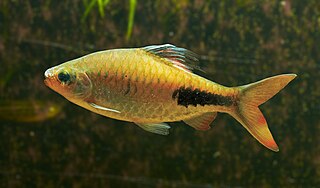
The rosy barb is a subtropical freshwater cyprinid fish found in southern Asia from Afghanistan to Bangladesh.

The black ruby barb or purplehead barb is a tropical cyprinid fish endemic to Sri Lanka, where it occurs in forested streams from the Kelani basin to the Nilwala basin. They are found in streams on hills around 1000 ft in elevation. The brightly colored population introduced to Mahaweli at Ginigathena, Sri Lanka, is said to have diminished in number due to the aquarium export trade.

Puntius is a genus of small freshwater fish in the family Cyprinidae native to South Asia and Mainland Southeast Asia, as well as Taiwan.

The ticto barb or twospot barb is a species of subtropical freshwater fish belonging to the family Cyprinidae. It is a native of the upper Mekong, Salwen, Irrawaddy, Meklong and upper Charo Phraya basins in the countries of Nepal, India, Pakistan, Myanmar, Bangladesh, Thailand, and Sri Lanka. It has frequently been confused with the Odessa barb in the aquarium trade, but in that species the male is reddish-orange.

Rasbora is a genus of fish in the family Cyprinidae. They are native to freshwater habitats in South and Southeast Asia, as well as southeast China. A single species, R. gerlachi, is only known from an old specimen that reputedly originated from Africa (Cameroon), but this locality is considered doubtful. They are small, up to 17 cm (6.7 in) long, although most species do not surpass 10 cm (4 in) and many have a dark horizontal stripe.

Mystus is a genus of fish in the family Bagridae native to Asia. Phylogenetic relationships within this genus are poorly understood, though it has been suggested that there are two major lineages.
Pethia bandula, commonly known as bandula barb, is a species of cyprinid endemic to Sri Lanka where it is only known from near Galapitamada in the Warakapola Divisional Secretariat. As this critically endangered species only was known from a single unprotected site where the population consists of an estimated 1,000 individuals, a second "insurance population" was established in 2014 by a team of IUCN scientists in cooperation with Sri Lanka's Forest Department, the Department of Wildlife Conservation and local communities.
Pethia cumingii, known as the Cuming's barb or the two spot barb, is a species of cyprinid fish endemic to Sri Lanka.

Dawkinsia assimilis is a species of ray-finned fish in the genus Dawkinsia. It is endemic to the southern Western Ghats especially to the Southwest Indian states of Karnataka and Kerala. They are known as Mascara Barb. Filament barbs are a group of small freshwater fishes found in the rivers of peninsular India and Sri Lanka. There are nine species known under the genus Dawkinsia. These barbs are popular among aquarium hobbyists as an ornamental fish and are also collected from rivers and bred for trade.
Pethia reval, the red-finned barb, is a species of cyprinid fish endemic to Sri Lanka. This species can reach a length of 3.4 centimetres (1.3 in) SL.

Dawkinsia singhala is a species of ray-finned fish in the genus Dawkinsia. It is found in Sri Lanka. The genus Dawkinsia is named after evolutionary biologist Richard Dawkins.

Dawkinsia srilankensis, the blotched filamented barb, is a species of ray-finned fish in the genus Dawkinsia. This species is endemic to the Kalu River in Sri Lanka and it is in imminent danger of going extinct due to tailings from upstream mines and potentially also capture for the aquarium trade. It was bred recently in the Dehiwala Zoological Gardens.

Rohan David Pethiyagoda is a Sri Lankan biodiversity scientist, amphibian and freshwater-fish taxonomist, author, conservationist and public-policy advocate.

Dawkinsia is a genus of cyprinid fishes from freshwater in South India and Sri Lanka. It was split off from genus Puntius in 2012.

Pethia is a genus of small freshwater fish in the family Cyprinidae native to South Asia, East Asia and Mainland Southeast Asia. Some species are commonly seen in the aquarium trade. The name Pethia is derived from the Sinhalese "pethia", a generic word used to describe any of several small species of cyprinid fishes. Most members of this genus were included in Puntius, until it was revised in 2012.
Pethia melanomaculata, is a species of cyprinid fish endemic to Sri Lanka.

Laubuka is a genus of cyprinid fish found in South and Southeast Asia.

Dawkinsia rohani is a species of ray-finned fish in the genus Dawkinsia. It is endemic to the Western Ghats and inhabits the hill streams of Kanyakumari District in Tamil Nadu draining into the Arabian Sea.

Rohanixalus is a genus of tree frogs in the family Rhacophoridae native to the Andaman islands and Indo-Burma region. The genus was established in 2020 by Indian herpetologist S.D. Biju of the University of Delhi and his colleagues. The genus comprises eight species.
Smiliogastrinae is a subfamily of freshwater ray-finned fishes belonging to the famly Cyprinidae, the family which includes the carps, barbs and relalted fishes. The fishes in this genus are found in Africa and Asia and are commonly referred to as barbs.














